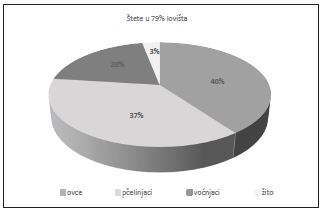Population status, protection and management of the brown bear (Ursus arctos) in the Republic of Srpska ̶ human dimension
DOI:
https://doi.org/10.7251/GSF1929057TKeywords:
brown bear, management plan, questionnaire, Republic of SrpskaAbstract
This paper represents a new step in understanding the actual status of the brown bear (Ursus arctos) population, which inhabits the area of the Republic of Srpska (RS). The results obtained by surveying 38 out of 42 (91%) organisations that deal with the brown bear population in the Republic of Srpska (hunting organizations, forestry, and national parks) serve as a basis for developing better management and protection of this species. All examinees of the survey have a very high opinion of the bear as a species, which is rated with an average score of 4.6 (from 1 ̶ very bad to 5 ̶ excellent). Most examinees (74%) are not sure what the actual number of bears in the Republic of Srpska is. The lack of implementation of CITES in RS is recognized as an important need to change existing legislation (65% of opinions) – razjasniti. The damage inflicted by bears is reported in 79% of hunting grounds, most often in livestock (40%) and apiaries (37%), then on orchards (20%) and grain (3%). The presence of bears with problematic behaviuor in the Republic of Srpska is reported by 50% of examinees, which is manifested in the continued occurrence of damage (58% of examinees), attacks on humans (11%), and movement through populated areas without fear of humans (11%). Furthermore, 74% of examinees think that the permanent removal of problematic individuals is the most effective solution. Poaching is identified as one of the biggest threats and reported in 61% of hunting grounds, and 81% of examinees find that the poaching rate in the Republic of Srpska is high (47%) and medium-high (34%). Concerning all the answers, we suggest an urgent creation of the Bear Management Plan as this could solve many problems, issues, and doubts regarding the management and better coexistence with this species in the Republic of Srpska.

Downloads
Published
Issue
Section
License
Copyright (c) 2019 Igor Trbojević, Jasmin Pašić, Mareike Brix, Oliver Stevanović, Tijana Trbojević

This work is licensed under a Creative Commons Attribution 4.0 International License.

